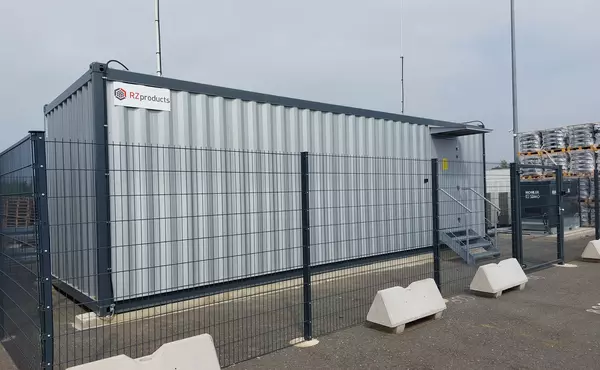With the growing use of AI and high-performance computing, traditional data centers are reaching their limits. What’s needed are new, compact infrastructure solutions that are powerful, scalable, and future-proof.
Artificial intelligence, machine learning, big data, and high-performance computing (HPC) are fundamentally transforming the IT landscape. Computing processes that once ran in a centralized, linear fashion are now dynamic, data-intensive, and more distributed than ever. They consume exponentially more computing power. The result: traditional data centers are increasingly hitting physical, technical, and energy-related limits—especially when it comes to real-time processing, high power density, or short-term scaling.
At the same time, the demands for flexibility, availability, and energy efficiency are rising. Companies, research institutions, and public organizations face the challenge of designing their IT infrastructures to respond to growing demands—economically, securely, and sustainably. Often, this fails due to the lack of scalability of existing infrastructure or simply because there is no physical space left. And this is true not only in urban centers, but also in remote or temporary deployment environments.
IT Infrastructure in Transition: More Flexibility, Less Downtime
The requirements for data centers are changing not only technologically but also conceptually. Whereas site location, capacity, and energy needs used to be planned far in advance, today the focus is on agile solutions that can adapt dynamically. AI-driven processes in particular require highly specialized infrastructures with high computing power while space is limited—keyword: power density.
This doesn’t just apply to large corporations—SMEs, universities, and public authorities also increasingly require powerful yet easily integrable IT solutions. As a result, demand is growing for modular, mobile, and scalable data centers that can be deployed at short notice while supporting state-of-the-art technology.
The Cooling Challenge: New Demands from High Density
With increasing power density come higher demands on the physical environment—especially the cooling system. Traditional air cooling quickly reaches its limits with modern server architectures, particularly GPU-based AI systems. A single HPC node today can generate several kilowatts of heat—too much for conventional cooling systems.
On-chip liquid cooling is therefore increasingly seen as a key technology for energy efficiency and operational security in high-density IT. In this approach, heat is removed directly at the source—on the chip itself. The result: higher packing density and reduced energy consumption for cooling. These technologies not only enable stable operation under high loads but also significantly improve energy efficiency. The enormous amount of waste heat also opens up additional opportunities for heat reuse.
Integrating such systems, however, requires that the data center is designed for these needs—posing a challenge for existing buildings but an advantage for newly designed, flexible solutions.
Scalable, Energy-Efficient, Secure – The Next Generation’s Requirements
Alongside cooling, factors such as power supply, fire protection, access security, and monitoring play a central role. Requirements range from redundant power supply and backup systems to physical security (e.g., burglary and explosion protection) as well as certifications such as ISO/IEC 27001, EN 50600, or industry-specific standards.
At the same time, awareness of sustainability is growing. Energy efficiency, CO₂ reduction, use of renewable energies, and waste heat recovery are no longer just cost factors but are now integral to ESG strategies and CSR initiatives. Modern data centers therefore need to be not only powerful but also environmentally conscious in their design—something much easier to achieve in new builds or modular systems than in legacy infrastructure.
Flexible Computing Power Out of the Box
Against this backdrop, mobile and container-based data centers are gaining strategic relevance. They address many of the challenges described above: as scalable infrastructure, as temporary sites, as extensions, or as stand-alone IT solutions in locations without existing IT infrastructure. They can be planned individually, set up almost anywhere, are quickly operational, and support highly available IT architectures. Depending on configuration, they provide space for traditional server racks, high-density IT, liquid cooling, and modular UPS and climate systems. Monitoring, security, and access solutions can also be directly integrated.
Quick Response to Innovation
Innovation cycles in IT are getting shorter—especially in the field of AI chips. Each new generation of chips brings not only higher computing performance but also increased demands on power supply, cooling, and infrastructure. Traditional data centers often can’t keep pace at the required speed. Container solutions, by contrast, make it possible to provide highly performant, ready-to-use infrastructures within just a few months—precisely tailored to current and future hardware generations.
The Data Center Group offers a flexible platform for precisely these requirements with its DC IT Containers: robust, fully welded outdoor data centers that meet the highest security standards and can be customized for a wide range of applications—whether for AI, edge, HPC, or classical IT workloads.
“Our container data centers provide the highest power density in the smallest space-up to 1 megawatt of IT power per unit. As such, this complete package offers the right answer to a wide variety of demands in today’s digitalized world,” says Christian Raab, Sales Manager Central Region of the Data Center Group.
![[Translate to English:] Datenströme in einer Rechtskurve](/fileadmin/user_upload/Bild__5_.png)


